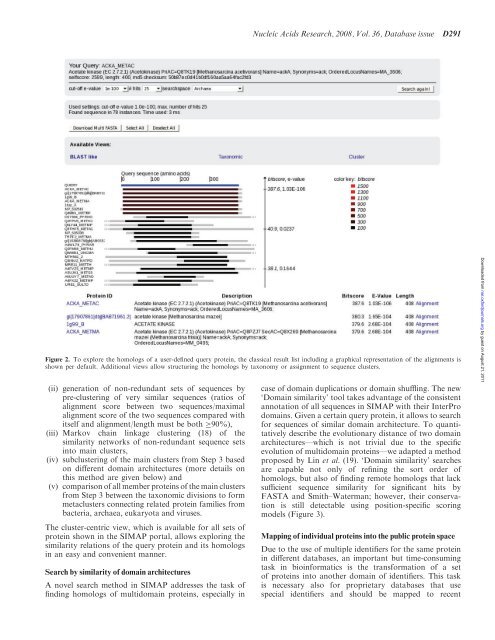SIMAPâstructuring the network of protein similarities
SIMAPâstructuring the network of protein similarities
SIMAPâstructuring the network of protein similarities
Create successful ePaper yourself
Turn your PDF publications into a flip-book with our unique Google optimized e-Paper software.
Nucleic Acids Research, 2008, Vol. 36, Database issue<br />
D291<br />
Figure 2. To explore <strong>the</strong> homologs <strong>of</strong> a user-defined query <strong>protein</strong>, <strong>the</strong> classical result list including a graphical representation <strong>of</strong> <strong>the</strong> alignments is<br />
shown per default. Additional views allow structuring <strong>the</strong> homologs by taxonomy or assignment to sequence clusters.<br />
(ii) generation <strong>of</strong> non-redundant sets <strong>of</strong> sequences by<br />
pre-clustering <strong>of</strong> very similar sequences (ratios <strong>of</strong><br />
alignment score between two sequences/maximal<br />
alignment score <strong>of</strong> <strong>the</strong> two sequences compared with<br />
itself and alignment/length must be both 90%),<br />
(iii) Markov chain linkage clustering (18) <strong>of</strong> <strong>the</strong><br />
similarity <strong>network</strong>s <strong>of</strong> non-redundant sequence sets<br />
into main clusters,<br />
(iv) subclustering <strong>of</strong> <strong>the</strong> main clusters from Step 3 based<br />
on different domain architectures (more details on<br />
this method are given below) and<br />
(v) comparison <strong>of</strong> all member <strong>protein</strong>s <strong>of</strong> <strong>the</strong> main clusters<br />
from Step 3 between <strong>the</strong> taxonomic divisions to form<br />
metaclusters connecting related <strong>protein</strong> families from<br />
bacteria, archaea, eukaryota and viruses.<br />
The cluster-centric view, which is available for all sets <strong>of</strong><br />
<strong>protein</strong> shown in <strong>the</strong> SIMAP portal, allows exploring <strong>the</strong><br />
similarity relations <strong>of</strong> <strong>the</strong> query <strong>protein</strong> and its homologs<br />
in an easy and convenient manner.<br />
Search by similarity <strong>of</strong> domain architectures<br />
A novel search method in SIMAP addresses <strong>the</strong> task <strong>of</strong><br />
finding homologs <strong>of</strong> multidomain <strong>protein</strong>s, especially in<br />
case <strong>of</strong> domain duplications or domain shuffling. The new<br />
‘Domain similarity’ tool takes advantage <strong>of</strong> <strong>the</strong> consistent<br />
annotation <strong>of</strong> all sequences in SIMAP with <strong>the</strong>ir InterPro<br />
domains. Given a certain query <strong>protein</strong>, it allows to search<br />
for sequences <strong>of</strong> similar domain architecture. To quantitatively<br />
describe <strong>the</strong> evolutionary distance <strong>of</strong> two domain<br />
architectures—which is not trivial due to <strong>the</strong> specific<br />
evolution <strong>of</strong> multidomain <strong>protein</strong>s—we adapted a method<br />
proposed by Lin et al. (19). ‘Domain similarity’ searches<br />
are capable not only <strong>of</strong> refining <strong>the</strong> sort order <strong>of</strong><br />
homologs, but also <strong>of</strong> finding remote homologs that lack<br />
sufficient sequence similarity for significant hits by<br />
FASTA and Smith–Waterman; however, <strong>the</strong>ir conservation<br />
is still detectable using position-specific scoring<br />
models (Figure 3).<br />
Mapping <strong>of</strong> individual <strong>protein</strong>s into <strong>the</strong> public <strong>protein</strong> space<br />
Due to <strong>the</strong> use <strong>of</strong> multiple identifiers for <strong>the</strong> same <strong>protein</strong><br />
in different databases, an important but time-consuming<br />
task in bioinformatics is <strong>the</strong> transformation <strong>of</strong> a set<br />
<strong>of</strong> <strong>protein</strong>s into ano<strong>the</strong>r domain <strong>of</strong> identifiers. This task<br />
is necessary also for proprietary databases that use<br />
special identifiers and should be mapped to recent<br />
Downloaded from nar.oxfordjournals.org by guest on August 21, 2011
















